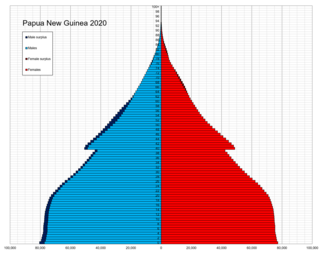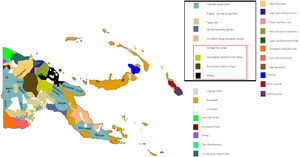
Papua New Guinea is a country in Oceania that comprises the eastern half of the island of New Guinea and its offshore islands in Melanesia. Officially the Independent State of Papua New Guinea, it shares its only land border with Indonesia to the west and it is directly adjacent to Australia to the south and the Solomon Islands to the east. Its capital, located along its southeastern coast, is Port Moresby. The country is the world's third largest island country, with an area of 462,840 km2 (178,700 sq mi).

The indigenous population of Papua New Guinea is one of the most heterogeneous in the world. Papua New Guinea has several thousand separate communities, most with only a few hundred people. Divided by language, customs, and tradition, some of these communities have engaged in endemic warfare with their neighbors for centuries. It is the second most populous nation in Oceania, with a total population estimated variously as being between 9.5 and 10.1 million inhabitants.
A pidgin, or pidgin language, is a grammatically simplified means of communication that develops between two or more groups of people that do not have a language in common: typically, its vocabulary and grammar are limited and often drawn from several languages. It is most commonly employed in situations such as trade, or where both groups speak languages different from the language of the country in which they reside.

Tok Pisin, often referred to by English speakers as New Guinea Pidgin or simply Pidgin, is a creole language spoken throughout Papua New Guinea. It is an official language of Papua New Guinea and the most widely used language in the country. However, in parts of the southern provinces of Western, Gulf, Central, Oro, and Milne Bay, the use of Tok Pisin has a shorter history and is less universal, especially among older people.

Melanesia is a subregion of Oceania in the southwestern Pacific Ocean. It extends from New Guinea in the west to the Fiji Islands in the east, and includes the Arafura Sea.

Bougainville Island is the main island of the Autonomous Region of Bougainville, which is part of Papua New Guinea. Its land area is 9,300 km2 (3,600 sq mi). The population of the whole province, including nearby islets such as the Carterets, is approximately 300,000. The highest point is Mount Balbi, on the main island, at 2,715 m (8,907 ft).

The indigenous peoples of Western New Guinea in Indonesia and Papua New Guinea, commonly called Papuans, are Melanesians. There is genetic evidence for two major historical lineages in New Guinea and neighboring islands: a first wave from the Malay Archipelago perhaps 50,000 years ago when New Guinea and Australia were a single landmass called Sahul and, much later, a wave of Austronesian people from the north who introduced Austronesian languages and pigs about 3,500 years ago. They also left a small but significant genetic trace in many coastal Papuan peoples.
Tayap is an endangered Papuan language spoken by fewer than 50 people in Gapun village of Marienberg Rural LLG in East Sepik Province, Papua New Guinea. It is being replaced by the national language and lingua franca Tok Pisin.
Hiri Motu, also known as Police Motu, Pidgin Motu, or just Hiri, is a language of Papua New Guinea, which is spoken in surrounding areas of Port Moresby.
In linguistics, Melanesian is an obsolete term referring to the Austronesian languages of Melanesia: that is, the Oceanic, Eastern Malayo-Polynesian, or Central–Eastern Malayo-Polynesian languages apart from Polynesian and Micronesian. A typical classification of the Austronesian languages ca. 1970 would divide them into something like the following branches:
Motu is a Central Papuan Tip language that is spoken by the Motuans, an indigenous ethnic group of Papua New Guinea. It is commonly used today in the region, particularly around the capital, Port Moresby.
Unserdeutsch, or Rabaul Creole German, is a German-based creole language that originated in Papua New Guinea as a lingua franca. The substrate language is assumed to be Tok Pisin, while the majority of the lexicon is from German.
The Yuat languages are an independent family of five Papuan languages spoken along the Yuat River in East Sepik Province, Papua New Guinea. They are an independent family in the classification of Malcolm Ross, but are included in Stephen Wurm's Sepik–Ramu proposal. However, Foley and Ross could find no lexical or morphological evidence that they are related to the Sepik or Ramu languages.
Vitu or Muduapa is an Oceanic language spoken by about 7,000 people on the islands northwest of the coast of West New Britain in Papua New Guinea.
Mehek is a Tama language spoken by about 6300 people in a somewhat mountainous area along the southern base of the Torricelli Mountains in northwestern Papua New Guinea. Mehek is spoken in six villages of Sandaun Province: Nuku, Yiminum, Mansuku, Yifkindu, Wilwil, and Kafle. Mehek is most closely related to Pahi, with 51% lexical similarity, and spoken approximately 20 kilometers to the southwest. Mehek is a fairly typical Papuan language, being verb-final, having a relatively simple phonology, and agglutinative morphology. There is very little published information about Mehek. The literacy rate in Tok Pisin, spoken by nearly everyone, is 50-75%. Mehek is not written, so there is no literacy in Mehek. Tok Pisin is primarily used in the schools, with 50% children attending. There is also a sign language used by the large number of deaf people in the Mehek community.
Pagi, or Bembi, is a Papuan language spoken by 2,000 people in five villages in Sandaun Province and in Vanimo District of Papua New Guinea, near the border with Indonesian Papua.

Native languages of Oceania fall into three major geographic groups:
Papuan Pidgin English was a 19th-century English-based pidgin of New Guinea. It was eventually replaced by Hiri Motu, a Melanesian-based pidgin, and was not ancestral to modern English-based Tok Pisin.
Tom Dutton was an Australian linguist specialising in Papuan languages and other languages of Papua New Guinea.












